Jan's Working with Databases
Forms & Reports: Special Types:
Label Wizard
One of the common tasks done with database information is to create mailing labels. Microsoft Access includes the Label Wizard to help you create labels for mailings, name tags and other purposes.
For
the wizard to work, you must know what size labels you are going to print
on. Manufacturers put the dimensions of the labels on the packaging, as
well has having product numbers. The wizard lists a number of
manufacturers and sizes, so you should be able to get a good match.








Envelopes: If you want to print addresses directly onto envelopes, it is easier to export the data to Word as a mail merge and use Word to do the envelopes.
Buying Label Stock
There are several things to consider when you buy label stock to print your own labels. There are many choices these days, including special purpose labels like name tags and file folder labels. Sheets of labels are a lot more expensive than plain paper. You want to get this right!
- Printer: Labels are available for laser and ink jet printers. There may still be some out there for dot matrix printers and for typewriters. Labels can be in separate sheets (most common!) or in continuous sheets. Choosing a type that matches your printer will make a difference in the quality of your finished labels.
- Size of label: How are you going to use the labels? What size do you need for the type to be large enough for your use.
- Price/Quality: Avery is the dominant company for labels but there are others, which may be cheaper.
Test First!
It is important that you check your print-out before actually printing on those expensive labels. Print a sheet or two of mailing labels on regular paper. Place your test sheet under a blank sheet of labels, carefully aligning the edges together. Hold the combination up to a light. You will be able to see the text underneath. Are the addresses are neatly within the edges of the labels or not?
Printers can be quite contrary! If the pages do not feed smoothly into the printer, your addresses will be crooked on the labels or may print across two labels. A wasted page!
Older printers may not have the correct printer drivers to communicate accurately with Access when it comes to picky layouts like labels. To get updated drivers, go the printer manufacturer's web site.
Step-by-Step: Label Wizard |
|
| What you will learn: | to use the Label Wizard |
Start with: ![]() , resource files, worldtravel-Lastname-Firstname.accdb from folder databases project4 as updated in the previous lesson
, resource files, worldtravel-Lastname-Firstname.accdb from folder databases project4 as updated in the previous lesson
Using the Label Wizard
- Select the Clients table in the Navigation Pane.
- On the Create ribbon tab in the Reports tab group, click the Labels button
 .
.
The Labels Wizard opens for you to choose a label manufacturer and a product.
-
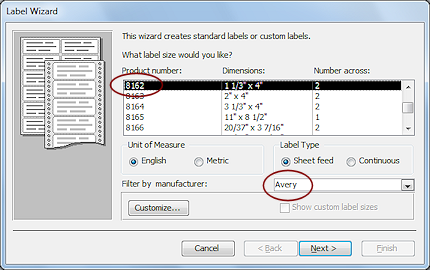 On
page 1 of the Label Wizard, select the following:
On
page 1 of the Label Wizard, select the following:
Manufacturer: Avery
Unit of Measure: English
Label Type: Sheet feed
Product#: 8162, size 1 1/3" x 4", with has two columns of labels per sheet

The sample labels at the left of the Label Wizard do not change to match your choice.The choices for products do change when you switch the unit of measure or the label type or the manufacturer.
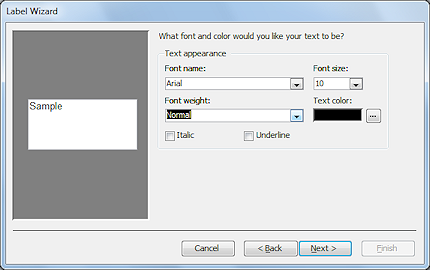 Click on Next.
Click on Next.
Page 2 of the Label Wizard lets you format the text for the label.
- On
page 2 of the Label Wizard, select the following:
Arial
10 pt.
Normal font weight
Leave the text color as black.
-
Click on Next.
Page 3 of the Label Wizard lets you choose what fields to put on the label.Prototype, in this case, means a model layout, which does not use actual data. You cannot tell from the prototype whether there is enough room for your data.
-
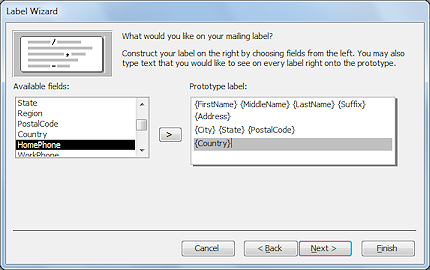 On
page 3 of the Label Wizard, click on the field FirstName in the list at the left.
On
page 3 of the Label Wizard, click on the field FirstName in the list at the left.
- Click the > button.
The field moves to the first line of the prototype label at the right.
- Press the spacebar to enter a space after the FirstName field.
- Similarly, add the MiddleName, LastName, and Suffix fields to the label, with a space between them
- After the Suffix field shows on the
label, press the Enter key.
The gray bar moves down one line.
- Add the Address field to the second line and press Enter.
- For the third line, add the fields City, State, PostalCode and press
Enter.
- For the fourth line, add the field Country.
- When your prototype label looks like the illustration, click the Next button.
The fourth page of the Label Wizard lets you choose fields to sort on.
-
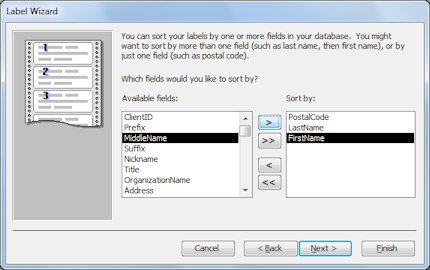 On
the fourth page of the Label Wizard, select the following
fields, one at a time and in this order and click the >
button to move each of them to the Sort by list:
On
the fourth page of the Label Wizard, select the following
fields, one at a time and in this order and click the >
button to move each of them to the Sort by list:
PostalCode
LastName
FirstName
- Click on Next.
The last page of the Label Wizard asks you for a name for the labels report.
-
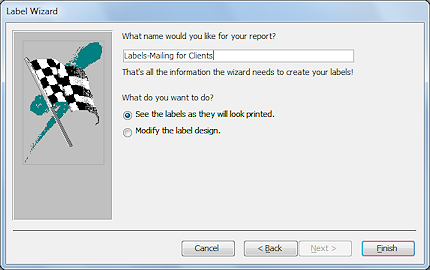 On
the fifth page of the Label Wizard, enter as the report's
name Labels-Mailing for Clients.
On
the fifth page of the Label Wizard, enter as the report's
name Labels-Mailing for Clients.
- Click on Finish.
The wizard closes and tries to open your new report.
 You may see a warning message that some data may not be displayed.
If the lines of text are long, they may not all fit.
You may see a warning message that some data may not be displayed.
If the lines of text are long, they may not all fit.
-
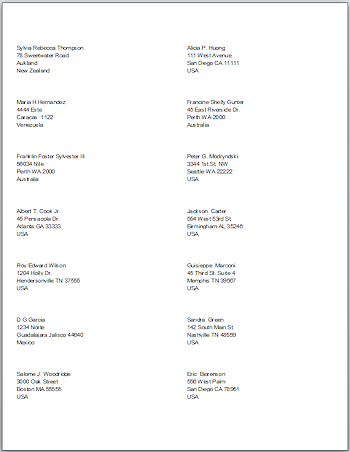 Click on OK.
Click on OK.
The report finally opens.
-
Inspect the report on screen carefully.
Are the fields wide enough to show complete addresses? Are there errors in the data? Are there blank records?
Some errors can be corrected by editing the report's design, like making a text box wider or setting CanGrow to Yes.
Others errors can be corrected by changing the source to filter out unwanted records.
Other errors are data input errors, which you correct by editing the records.
-
 Print (on normal paper).
Print (on normal paper).
Normally I would ask you to put your name on the page header, but that throws off the layout.
-
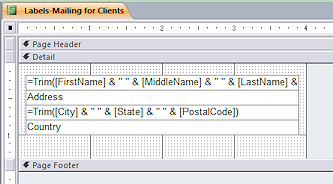
 Switch to Design View.
Switch to Design View.
You can see that the report is just a few text boxes that concatenate some fields.
The Trim function trims off any extra spaces at the beginning and end of the text.
You could create your own label report. The tricky part is getting the size of the Detail section exactly right so that the text is on the labels correctly and to get the columns working correctly. (See the upcoming lesson Multiple Columns) This can be very frustrating to do on your own. Thank you, Avery, for working with Microsoft to provide these templates!
